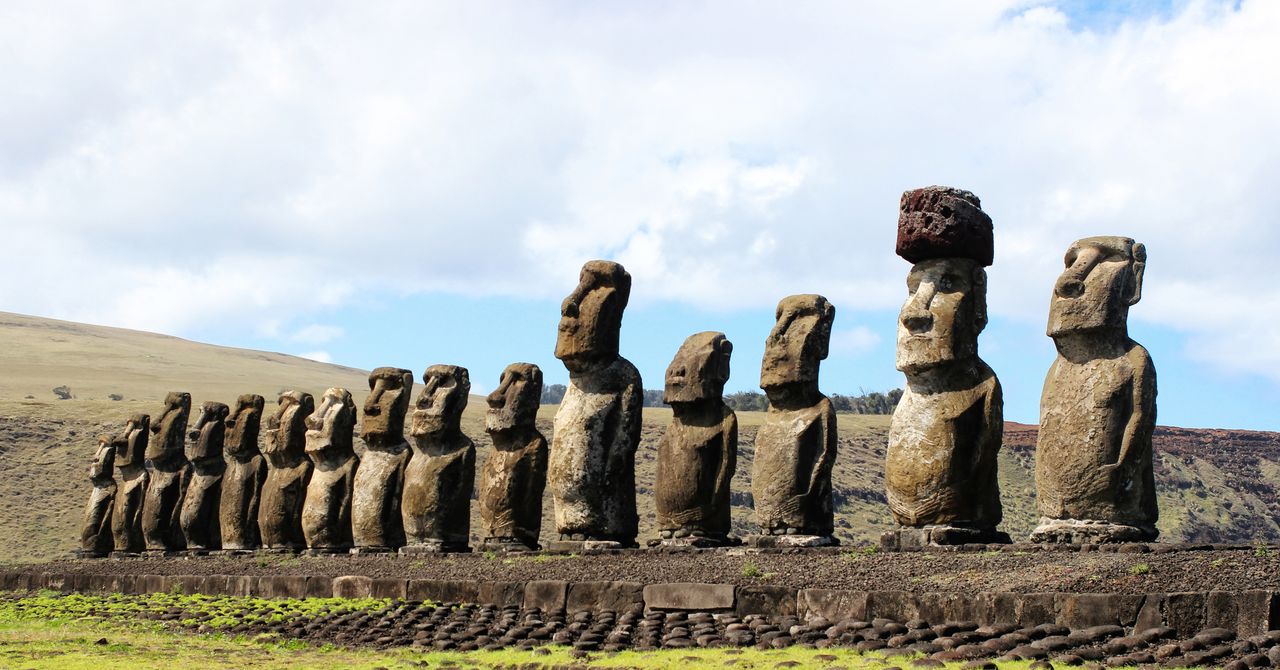The enigmatic Moai statues of Easter Island, or Rapa Nui, have captivated the world for centuries. These monolithic figures, scattered across the remote South Pacific island, stand as silent witnesses to a lost civilization. The question of how these colossal statues, some weighing several tons, were transported to their current locations has puzzled archaeologists and historians alike. Now, new research offers compelling evidence that the Moai may have ‘walked’ to their destinations, challenging long-held beliefs and providing fresh insights into the ingenuity of the ancient Polynesians.
This article delves into the groundbreaking study that sheds light on the Moai’s transport, exploring the methods, evidence, and implications of this fascinating discovery. Join us as we uncover the secrets of Easter Island and unravel the mystery of the walking statues.
The Moai Enigma: Unveiling the Mystery of Easter Island’s Statues
Easter Island, a tiny speck of land in the vast expanse of the South Pacific, is home to nearly 1,000 Moai statues. Carved from volcanic rock, these imposing figures represent the ancestors of the Rapa Nui people, who inhabited the island for centuries. The Moai vary in size and weight, with some reaching over 30 feet in height and weighing up to 80 tons. Their construction and placement reflect the Rapa Nui’s advanced engineering skills.
The traditional theory suggested that the Moai were dragged across the island on wooden sleds or rollers. However, this explanation requires vast quantities of timber, a resource that was scarce on Easter Island. Furthermore, archaeological evidence supporting this theory has been elusive.
The Walking Theory: A New Perspective on Moai Transport
In 2012, a US research team proposed a radical new theory: the Moai ‘walked’ to their locations. This theory, based on experiments and archaeological evidence, suggests that the statues were moved in an upright position, using a rocking motion similar to how one might move a refrigerator.
Carl Lipo, an anthropologist at Binghamton University, explained, “Once the moai are in motion, it’s not at all difficult.” Lipo and his team systematically surveyed 962 moai statues on Easter Island, focusing primarily on 62 found along ancient roads, providing strong evidence that moai were transported in an upright position.
Evidence and Experiments: Supporting the Walking Hypothesis
The ‘walking’ theory is supported by several lines of evidence. First, the Moai have a distinctive D-shaped base, which is ideal for rocking the statues back and forth. Second, the ancient roads on Easter Island are slightly concave, which would have helped to stabilize the Moai during transport. Finally, experiments have shown that it is possible to move a Moai replica using the ‘walking’ method with a relatively small team of people.
The team also succeeded in moving an exact replica of roadside moai 100 meters in 40 minutes with only 18 people, a far more efficient result than those of previous experiments.
Challenges and Objections: Addressing Alternative Explanations
The ‘walking’ theory has not been without its critics. Some researchers have argued that the method would have been too difficult or dangerous, particularly on uneven terrain. Others have questioned the availability of ropes and other materials needed for the transport.
Challenges to the walking hypothesis have focused primarily on topographic constraints, rope availability, and weather patterns, but these objections, the researchers say, aren’t adequately backed by comprehensive archaeological evidence.
Rapa Nui Traditions: Echoes of the Walking Statues
Adding further weight to the ‘walking’ theory are the oral traditions of the Rapa Nui people. These traditions speak of the Moai walking from the quarry to their final locations, guided by the power of the ancestors. While oral traditions should always be interpreted with caution, they provide valuable insights into the beliefs and practices of the past.
The researchers also defer to oral traditions of Rapa Nui that speak to the belief that moai walked from the quarry to their current locations.
Implications and Legacy: What the Walking Statues Tell Us
The ‘walking’ theory has significant implications for our understanding of Easter Island and the Rapa Nui civilization. It suggests that the Rapa Nui were skilled engineers and problem-solvers who were able to overcome the challenges of transporting the Moai without the need for vast quantities of resources.
The study is a tribute to the ingenuity of the Rapa Nui people, Lipo emphasizes. Compared to the conventional theories of horizontal transport, the walking method requires the least amount of labor and materials. Modern man, Lipo notes, has much to learn from this ancient, highly efficient feat of engineering.
Conclusion: A New Chapter in the Story of Easter Island
The mystery of Easter Island’s Moai statues has captivated the world for generations. While the ‘walking’ theory may not be the final word on the subject, it provides a compelling new perspective on how these iconic figures were transported. By combining archaeological evidence, experiments, and oral traditions, researchers have painted a vivid picture of the ingenuity and resourcefulness of the Rapa Nui people.
As we continue to explore Easter Island and its rich history, we can learn valuable lessons about the challenges and triumphs of ancient civilizations. The Moai statues stand as a testament to the power of human innovation and the enduring legacy of the Rapa Nui people.

Leave a Reply